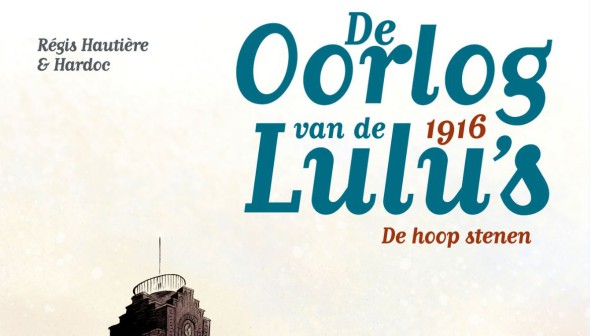
Written by: Régis Hautière
Illustrations: Hardoc
Coloring: Hardoc, David François
Publisher: Casterman
De Oorlog van de Lulu’s 1916 De Hoop Stenen – Comic Book Review
With the First World War having been fought about a hundred years ago, it is only natural that there are all sorts of initiatives to remember this horrible event by. It was only to be expected that there would also be new comic books revolving around the atrocities committed during that time. ‘De oorlog van de Lulu’s’ is one of those comic book series. It tells us the story of five young orphans trying to survive on their own in these terrifying times.
It’s 1916 and the war still rages on fiercely. The Lulus are roaming around France, trying to stay out of sight of the Germans. These orphaned kids got stuck behind enemy lines by an unfortunate coincidence, and now they have to try and survive without being caught. After roaming around for some time in the woods, they suddenly see a house. The man who lives there turns out to be very friendly and advises them to go to Guise, a town in northern France, not too far from where they currently are. In Guise they will be less conspicuous, and they might even find somewhere dry to stay for a little while. Following the old man’s advice, they arrive in Guise a few days later. There they soon find an abandoned house which they are happy to occupy. Unfortunately, before they even have a chance to get settled, Luigi injures his leg and needs a doctor to look after the wound properly. Luckily, while exploring the neighborhood, Lucy and Lucien meet a nice old lady, who advises them to go to the Familistère, a building just outside the city where all employees of the factory are housed in rather luxurious rooms, and are even accommodated with a pool, a theater, schools, shops and so on. Now that there’s war, all of this isn’t what it used to be, but people still live there rather happily and they are prepared to help the children as soon as they arrive, even providing them shelter in the attics for as long as Luigi’s wound hasn’t healed. They have to be careful though, as the Germans occupy the ground floor of the buildings.
Régis Hautière really takes his time to tell the story of these five children. The pace is never too fast, but doesn’t bore either. Instead, we get a good idea of how the children try to survive, and the people they meet, who all try to help them as much as they can. There is some excitement to be found here and there, and even though there is quite some solidarity in this issue, it is also clear the whole time that the war is far from over, and life will never be the same as before.
This feeling is only confirmed by Hardoc’s illustrations. The backgrounds almost look as if they were painted, rather than drawn, with beautiful colors fading into each other. The overall color palette looks rather grim, which sets the mood perfectly. This always makes you remember that the war isn’t far off, and hard times will come.
The Familistère is a building that actually exists, and was built as a social experiment in the nineteenth century. All employees of the factory lived together, in the same building as the manager himself. It is very nice to see this implemented in this story, as it makes it even more realistic, while arousing curiosity.
The Germans in this comic book series really speak German. Luckily their text is translated at the bottom of each page, but this too adds to the credibility of the story. However, sometimes it does hold the flow of the story back somewhat, as you will each time have to read the translation as well.
Conclusion
De Oorlog van de Lulu’s 1916 De Hoop Stenen is an intriguing story set during the First World War. At times it is heartwarming, while it stays constantly clear that the war is still raging on. We are already anxious to see how the Lulus’ story will end.
De Oorlog van de Lulu's 1916 De Hoop Stenen - Comic Book Review,





No Comments